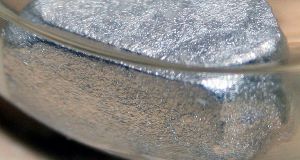The chemical element potassium is classed as an alkali metal . It was discovered in 1806 by Sir Humphry Davy.

Data Zone
| Classification: | Potassium is an alkali metal |
| Color: | silvery-white |
| Atomic weight: | 39.0983 |
| State: | solid |
| Melting point: | 63.4 oC, 336.5 K |
| Boiling point: | 765.6 oC, 1038.7 K |
| Electrons: | 19 |
| Protons: | 19 |
| Neutrons in most abundant isotope: | 20 |
| Electron shells: | 2,8,8,1 |
| Electron configuration: | 1s2 2s2 2p6 3s2 3p6 4s1 |
| Density @ 20oC: | 0.862 g/cm3 |
Reactions, Compounds, Radii, Conductivities
| Atomic volume: | 45.46 cm3/mol |
| Structure: | bcc: body-centered cubic |
| Hardness: | 0.4 mohs |
| Specific heat capacity | 0.75 J g-1 K-1 |
| Heat of fusion | 2.334 kJ mol-1 |
| Heat of atomization | 89 kJ mol-1 |
| Heat of vaporization | 79.870 kJ mol-1 |
| 1st ionization energy | 418.8 kJ mol-1 |
| 2nd ionization energy | 3051.3 kJ mol-1 |
| 3rd ionization energy | 4411.3 kJ mol-1 |
| Electron affinity | 48.385 kJ mol-1 |
| Minimum oxidation number | 0 |
| Min. common oxidation no. | 0 |
| Maximum oxidation number | 1 |
| Max. common oxidation no. | 1 |
| Electronegativity (Pauling Scale) | 0.82 |
| Polarizability volume | 43.4 Å3 |
| Reaction with air | vigorous, ⇒ KO2 |
| Reaction with 15 M HNO3 | vigorous, ⇒ H2, NOx, KNO3 |
| Reaction with 6 M HCl | vigorous, ⇒ H2, KCl |
| Reaction with 6 M NaOH | vigorous, ⇒ H2, KOH |
| Oxide(s) | K2O |
| Hydride(s) | KH |
| Chloride(s) | KCl |
| Atomic radius | 220 pm |
| Ionic radius (1+ ion) | 152 pm |
| Ionic radius (2+ ion) | – |
| Ionic radius (3+ ion) | – |
| Ionic radius (1- ion) | – |
| Ionic radius (2- ion) | – |
| Ionic radius (3- ion) | – |
| Thermal conductivity | 102.5 W m-1 K-1 |
| Electrical conductivity | 16.4 x 106 S m-1 |
| Freezing/Melting point: | 63.4 oC, 336.5 K |

Potassium metal. Image by Schmidi.

Davy (on the bellows) at a public demonstration of science at the Royal Institution in London. Image by James Gillray.
Discovery of Potassium
In 1806 English chemist Sir Humphry Davy discovered that chemical bonding was electrical in nature and that he could use electricity to split substances into their basic building blocks – the chemical elements.
In 1807 he isolated potassium for the first time at the Royal Institution, London. He electrolyzed dried potassium hydroxide (potash) which he had very slightly moistened by exposing it to the moist air in his laboratory. The electrolysis was powered by the combined output of three large batteries he had built.
When he applied a voltage from his batteries to the potassium hydroxide, he found globules “having a high metallic lustre” collected at the negatively charged electrode. (1)
Edmund Davy, who assisted in the experiment, described Sir Humphry Davy’s reaction to the production of potassium metal, his Eureka moment:
“… when the minute globules of potassium burst through the crust of potash, and take fire as they entered the atmosphere, he could not contain his joy – he actually danced about the room in ecstatic delight; some little time was required for him to compose himself sufficiently to continue the experiment.” (2)
Potassium was the first metal to be isolated by electrolysis.
Davy was astonished at the new metal’s low density, observing that it floated on oil – something no other metal would do. He placed a piece of potassium in water and observed that the water, “decomposes it with great violence, an instantaneous explosion with brilliant flame. He also (bravely) added potassium to hydrochloric acid and saw it burn with a bright red flame. (3)
The name potassium is from the English word ‘potash’, originally meaning an alkali extracted with water in a pot of ash of burned wood or tree leaves.
Potassium’s symbol K comes from ‘kalium’ the name of the element in Germany and Scandinavia. (4)
Just a few days after isolating potassium, Davy isolated sodium for the first time using the same method.
Interesting Facts aboutPotassium
- Potassium and its close periodic table neighbor sodium are solids at room temperature. Their alloys however are not. NaK alloys containing 40 to 90 percent of potassium by weight are liquids at room temperature. The commercially available 78% K, 22% Na alloy stays liquid at temperatures as low as -12.6 oC (9.3 oF).
- All living cells need potassium to maintain fluid balance, therefore we and all other forms of life on Earth need potassium minerals to survive. Potassium is available in all meats, plants and dairy products. Fruit and vegetables are the best sources of potassium.
- Several neurotoxins work by disrupting our cells’ biological use of potassium. This can result in severe pain, or even death. These neurotoxins include agitoxin, charybdotoxin and margatoxin (scorpion stings), apamin (bee stings), and dendrotoxin (mamba snake bites).
- Most of the universe’s potassium atoms were made in the final moments of giant stars as they exploded in supernovae. Potassium is made in the oxygen burning shell of stars when they explode. This is not normal burning, of course; it is nuclear fusion. Potassium is made, along with several other elements including sulfur, and silicon, during explosive oxygen burning in supernovae.
- All plants need potassium to survive; over 90% of all human use of potassium compounds is in the manufacture of plant fertilizers.
- People whose diets are low in potassium can suffer from hypokalemia. Severe hypokalemia can be life threatening. Symptoms include irregular heartbeat, fatigue, muscle cramps and constipation. It is unusual for people to be deficient in potassium solely as a result of getting too little in their diets. Usually hypokalemia is caused by other issues such as diarrhea and/or vomiting, use of antibiotics, and kidney disease.
- Most people are familiar with carbon dating, which uses the decay of the radioactive carbon-14 isotope to find the ages of once-living things such as animal and plant matter. The radioactive isotope potassium-40 gives us a way of dating rocks. Potassium-40 decays to argon-40 and calcium-40 with a half-life of 1.25 billion years. The ratio of potassium-40 to argon-40 trapped in rock is used to determine how long it is since the rock has solidified.

Appearance and Characteristics
Harmful effects:
In healthy people with normal kidney function, a potassium intake from foods does not seem to pose potential for increased risk, because excess potassium is readily excreted in the urine. In people whose urinary excretion of potassium is impaired, a potassium intake below 4.7 g (120 mmol)/day is appropriate because of adverse cardiac effects. If the digestive system is bypassed and potassium salts are injected into a vein, the heart can be stopped. (5) (6) (7)
Due to its highly reactive nature, elemental potassium must be handled with extreme care.
Characteristics:
Potassium is silvery-white, low melting, metal soft enough to be easily cut with a knife. It tarnishes rapidly in air, forming a dull oxide coating.
Potassium burns with a lilac colored flame. It is extremely reactive, reacting violently with water, for example, to produce hydrogen gas and potassium hydroxide.
Potassium is a very light metal (the second least dense metal after lithium) and would float on water if it were not so reactive.
Uses of Potassium
Potassium is vital for plant growth. Plants use it, for example, to make proteins, hence the greatest demand for potassium compounds is in fertilizers.
Potassium hydroxide is a strong alkali and an important industrial chemical. It is used in the manufacture of soft soaps and as an electrolyte in alkaline batteries.
Potassium chloride is used as a healthier alternative to table salt.
Toughened glass can be made by immersing glass in molten potassium nitrate.
Potassium nitrate is the main explosive ingredient in gunpowder.
Abundance and Isotopes
Abundance earth’s crust: 2.1 % by weight, 1.6 % by moles
Abundance solar system: 4 parts per million by weight, 100 parts per billion by moles
Cost, pure: $100 per 100g
Cost, bulk: $65 per 100g
Source: Potassium does not occur as a free element in nature; it is too reactive, forming compounds from which it is difficult to separate. Potassium is obtained commercially by electrolysis of potassium hydroxide or potassium chloride
Isotopes: Potassium has 20 isotopes whose half-lives are known, with mass numbers 35 to 54. Naturally occurring potassium is a mixture of three isotopes and they are found in the percentages shown: 39K (93.6%), 40K (0.01%), and 41K (6.7%).

References
- John Davy (Editor), The Collected Works of Sir Humphry Davy, Vol V, 1840, p61 Smith, Elder and Co. Cornhill.
- John Davy, Memoirs of the Life of Sir Humphry Davy, 1836, p384 Longman.
- John Davy (Editor), The Collected Works of Sir Humphry Davy, Vol V, 1840, p68 Smith, Elder and Co. Cornhill.
- Vivi Ringnes, Origin of the Names of Chemical Elements., J. Chem. Educ., 1989, 66 (9), p731.
- Potassium, The National Acadamies Press
- Potassium, Linus Pauling Institute
- Ellie Whitney, Eleanor Noss Whitney, Sharon Rady Rolfes, Understanding Nutrition., p400, 2010 Cengage Learning
Cite this Page
For online linking, please copy and paste one of the following:
<a href="https://www.chemicool.com/elements/potassium.html">Potassium</a>
or
<a href="https://www.chemicool.com/elements/potassium.html">Potassium Element Facts</a>
To cite this page in an academic document, please use the following MLA compliant citation:
"Potassium." Chemicool Periodic Table. Chemicool.com. 17 Oct. 2012. Web. <https://www.chemicool.com/elements/potassium.html>.